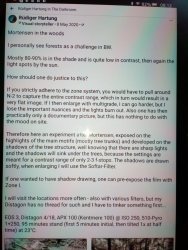It does seem to be true that reciprocity can generate a tortoise-and-hare situation and it does seem to be possible to follow both of them down an infinite rabbit hole. There may be no perfect solution.
What is interesting to me about this is that neither of the negatives in question required going down the expose-contracted development rabbit hole.
D-23 naturally compensates the highlights, and EMA - an
expanded development method - protects both the mid-tone local contrast and reigns in the highlights.
I did a similar comparison with negatives done in divided Pyrocat-HD and Semistand Pyrocat-HD - with similar good results, at least from an initial scan of the negatives. (Nothing really counts for me until I silver print for final judgment.)
David Kachel has made the point in public and also in a private email to me that Zone system got contraction all wrong. If you do it the Ansel Adams way, you get muddy mid-tone local contrast. I think he is entirely right in this matter. Beyond the basics of composition and good focus, I have a basic model I want designed into all my negatives:
- Proper shadow exposure
- Preservation or expansion of local contrast in the dominant part of the image
- Protecting the highlights from blocking
Having now explored (Semi)stand, EMA, divided development, and a compensating developer, I am entirely confident that it is possible to manage the last two of these very directly. One need only note which technique you are planning to develop with because it does affect film speed.
So, all I now worry about is the first - making sure I give the shadows sufficient exposure. This is the #1 sin I see committed with many negatives (my own included). I no longer care if the highlights fall on X or even above - these techniques solve that problem. Instead, I make sure my shadows are properly and fully placed and exposed.
As a general matter, if the dominant local contrast is OK in the scene, there is no reason to use low agitation techniques (unless getting full film speed is important for some reason). In the scenario where there is a high SBR and good local contrast, a compensating developer like D-23 1:1 or divided Pyrocat-HD is all you need. Low agitation is primarily indicated if you: A) Want to crank up local contrast and/or B) Want to exploit the adjacency effects these techniques produce.
Anyway, that's my story for the moment and I'd love to hear the experiences of others ...
Coda: It's also worth noting that these techniques will not solve the problem that a negative holds far more range of light than any paper could possibly reproduce. This is to your point about negatives just being a vehicle to get to a final image. What these techniques
do provide, though, is more choices during the printing session about which range of light you want to reproduce in which sections of the print.





